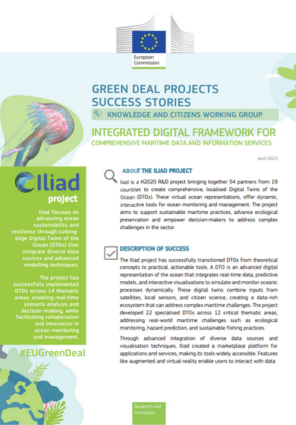About the project
ILIAD creates comprehensive, localised Digital Twins of the Ocean (DTOs) across 19 countries and with the collaboration of 54 partners. Digital twins are digital models of real-life systems and these virtual representations of the sea offer dynamic, interactive tools for ocean monitoring and management. The project aims to support sustainable maritime practices, advance ecological preservation and empower decision-makers to address complex challenges in the sector.
Description of success
ILIAD has successfully transitioned DTOs from theoretical concepts to practical, actionable tools. A DTO is an advanced digital representation of the ocean that integrates real-time data, predictive models, and interactive visualisations to simulate and monitor oceanic processes dynamically. These digital twins combine inputs from diverse data sources, such as satellites, local sensors, and citizen science, creating a data-rich ecosystem that can address complex maritime challenges. Advanced visualisation techniques were used that involved combining virtual and augmented reality.
The project developed 22 specialised DTOs across 12 critical thematic areas, addressing real-world maritime challenges such as ecological monitoring, hazard prediction, and sustainable fishing practices. The DTOs can be used to model management scenarios and therefore aid in decision-making. Features like augmented and virtual reality enable users to interact with data in innovative ways, while the system’s "what-if" scenarios enhance decision-making capabilities. This interoperability with existing EU Earth observation infrastructure highlights ILIAD’s value for scientific, commercial, and policy applications.
ILIAD has created a marketplace, providing access to the DTOs, amongst other applications, plug-ins and services, making its tools widely accessible.

Figure 1: The Iliad DTOs will fuse a large volume of diverse data in a semantically rich and data-agnostic approach to enable simultaneous communication with real-world systems and models.
Highlights
Development of 22 specialised DTOs addressing issues like ecological monitoring, hazard response, and sustainable fisheries.
Creation of an open marketplace platform for distributing innovative applications, interfaces, and services.
Integration of diverse data sources, including microplastic sensors, UAVs, and advanced Earth observation tools.
Advanced visualisation technologies, such as augmented and virtual reality, enabling immersive interaction and scenario modelling.
Engagement of citizen scientists through interactive tools like hazard reporting apps and educational games.
Outputs
As well the DTOs, ILIAD has developed technological components that are available on its marketplace, including the Ocean Information Model – a tool that enables interoperability and data exchange between existing models relevant to the ocean, avoiding the need to develop new models.
To model a system as complex as the ocean, implementing sensors that monitor a range of sources is vital. The sensors that ILIAD integrated include: flow and wave meters; unmanned aerial vehicles (UAVs); microplastic sensor; and anoxia and ecological sensors.
Citizen science has played an important role in collecting the data necessary to develop the DTOs and. ILIAD has harnessed citizen science by implementing the following methodologies:
I SEE SEA (ICC) application– platform for citizens to report unusual phenomena such as jellyfish swarms, weather changes, and coastal pollution.
Lemon application - an Android app for ballast water management
Analysis of social media data to detect and monitor oil spills, and validate oil spill models.
ILIAD has created educational and policy tools to maximise its impact, including a policy brief on how DTOs advance policy targets and the ILIAD Academy educational hub.
Impact
ILIAD has revolutionised ocean monitoring and prediction, contributing significantly to the EU Green Deal and digital strategy innovations. Its DTOs provide actionable insights for better decision-making, support sustainable ocean economy development, and advance global efforts like the UN Ocean Decade. The platform’s ability to integrate diverse data sources and facilitate cross-disciplinary collaboration enhances its potential to address complex marine and climate challenges effectively.
Lessons
Development of the DTOs demonstrates the complexity and variety of ocean-related challenges that can be addressed through digital twinning.
Data model interoperability is crucial for the future, as multiple EU-funded initiatives are working in parallel on creating digital twins.
Co-design with end users is essential but requires significant time investment, often longer than anticipated.
Each DTO required local data alongside global observations, meaning that a “one-size-fits-all" approach to developing DTOs is not effective.
Collaboration and data sharing are vital for comprehensive ocean monitoring and prediction due to the complexity of the system.
Integration of citizen science and expert knowledge enhances the value and applicability of DTOs.
Other information
Read more about DTOs and why we need them on the ILIAD website.
Visit the Iliad Marketplace.

